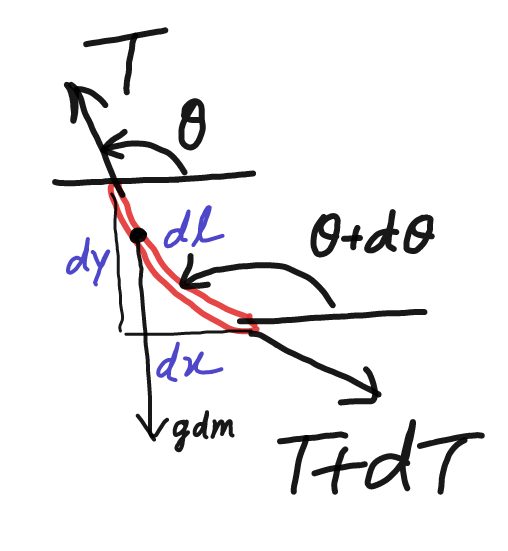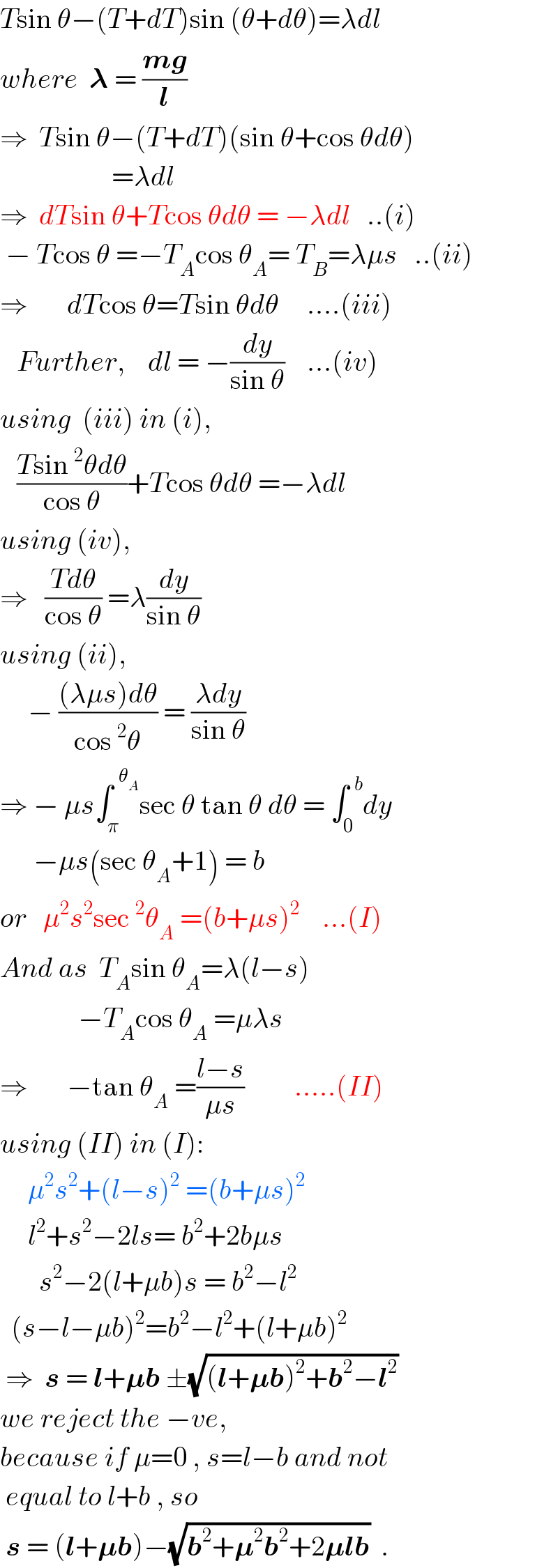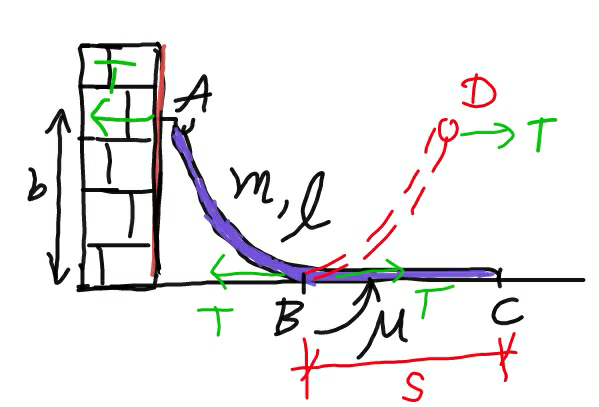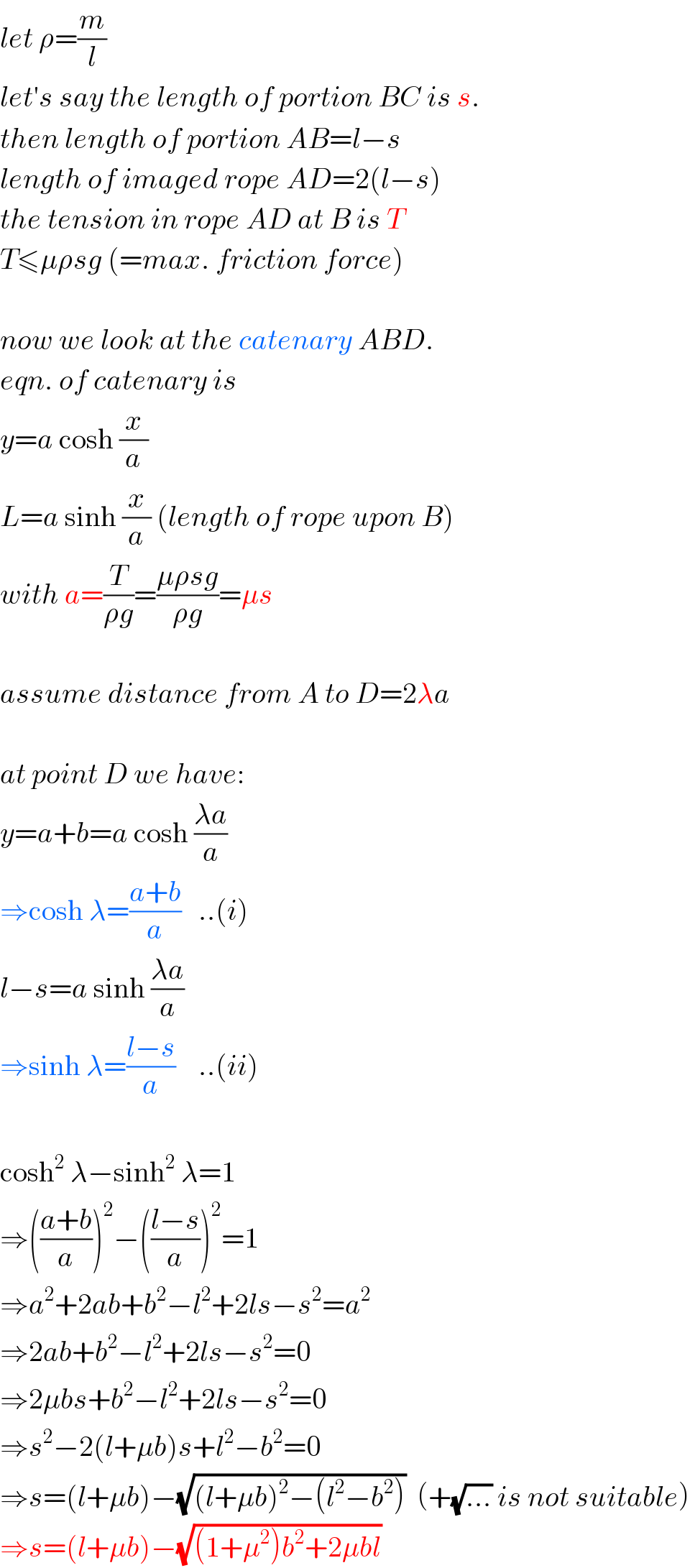Question Number 29559 by ajfour last updated on 09/Feb/18

Commented by ajfour last updated on 10/Feb/18

$${Find}\:{minimum}\:{length}\:{of}\:{portion} \\ $$$${BC}\:{of}\:{rope}\:{ABC}\:{of}\:{length}\:{l},\:{mass} \\ $$$${m},\:{in}\:{contact}\:{with}\:{ground}. \\ $$
Commented by ajfour last updated on 10/Feb/18

$${my}\:{answer}\:{to}\:{the}\:{question}: \\ $$$${s}\:=\:{l}+\mu{b}−\sqrt{{b}^{\mathrm{2}} +\mu^{\mathrm{2}} {b}^{\mathrm{2}} +\mathrm{2}\mu{bl}}\:\:. \\ $$
Commented by ajfour last updated on 10/Feb/18

Commented by ajfour last updated on 10/Feb/18

$${T}\mathrm{sin}\:\theta−\left({T}+{dT}\right)\mathrm{sin}\:\left(\theta+{d}\theta\right)=\lambda{dl} \\ $$$${where}\:\:\boldsymbol{\lambda}\:=\:\frac{\boldsymbol{{mg}}}{\boldsymbol{{l}}} \\ $$$$\Rightarrow\:\:{T}\mathrm{sin}\:\theta−\left({T}+{dT}\right)\left(\mathrm{sin}\:\theta+\mathrm{cos}\:\theta{d}\theta\right) \\ $$$$\:\:\:\:\:\:\:\:\:\:\:\:\:\:\:\:\:\:\:\:=\lambda{dl}\:\:\:\:\:\:\:\:\: \\ $$$$\Rightarrow\:\:{dT}\mathrm{sin}\:\theta+{T}\mathrm{cos}\:\theta{d}\theta\:=\:−\lambda{dl}\:\:\:..\left({i}\right) \\ $$$$\:−\:{T}\mathrm{cos}\:\theta\:=−{T}_{{A}} \mathrm{cos}\:\theta_{{A}} =\:{T}_{{B}} =\lambda\mu{s}\:\:\:..\left({ii}\right) \\ $$$$\Rightarrow\:\:\:\:\:\:\:{dT}\mathrm{cos}\:\theta={T}\mathrm{sin}\:\theta{d}\theta\:\:\:\:\:….\left({iii}\right) \\ $$$$\:\:\:{Further},\:\:\:\:{dl}\:=\:−\frac{{dy}}{\mathrm{sin}\:\theta}\:\:\:\:…\left({iv}\right) \\ $$$${using}\:\:\left({iii}\right)\:{in}\:\left({i}\right), \\ $$$$\:\:\:\frac{{T}\mathrm{sin}\:^{\mathrm{2}} \theta{d}\theta}{\mathrm{cos}\:\theta}+{T}\mathrm{cos}\:\theta{d}\theta\:=−\lambda{dl} \\ $$$${using}\:\left({iv}\right), \\ $$$$\Rightarrow\:\:\:\frac{{Td}\theta}{\mathrm{cos}\:\theta}\:=\lambda\frac{{dy}}{\mathrm{sin}\:\theta} \\ $$$${using}\:\left({ii}\right), \\ $$$$\:\:\:\:\:−\:\frac{\left(\lambda\mu{s}\right){d}\theta}{\mathrm{cos}\:^{\mathrm{2}} \theta}\:=\:\frac{\lambda{dy}}{\mathrm{sin}\:\theta} \\ $$$$\Rightarrow\:−\:\mu{s}\int_{\pi} ^{\:\:\theta_{{A}} } \mathrm{sec}\:\theta\:\mathrm{tan}\:\theta\:{d}\theta\:=\:\int_{\mathrm{0}} ^{\:\:{b}} {dy} \\ $$$$\:\:\:\:\:\:−\mu{s}\left(\mathrm{sec}\:\theta_{{A}} +\mathrm{1}\right)\:=\:{b} \\ $$$${or}\:\:\:\mu^{\mathrm{2}} {s}^{\mathrm{2}} \mathrm{sec}\:^{\mathrm{2}} \theta_{{A}} \:=\left({b}+\mu{s}\right)^{\mathrm{2}} \:\:\:\:…\left({I}\right) \\ $$$${And}\:{as}\:\:{T}_{{A}} \mathrm{sin}\:\theta_{{A}} =\lambda\left({l}−{s}\right) \\ $$$$\:\:\:\:\:\:\:\:\:\:\:\:\:\:−{T}_{{A}} \mathrm{cos}\:\theta_{{A}} \:=\mu\lambda{s} \\ $$$$\Rightarrow\:\:\:\:\:\:\:−\mathrm{tan}\:\theta_{{A}} \:=\frac{{l}−{s}}{\mu{s}}\:\:\:\:\:\:\:\:\:…..\left({II}\right) \\ $$$${using}\:\left({II}\right)\:{in}\:\left({I}\right): \\ $$$$\:\:\:\:\:\mu^{\mathrm{2}} {s}^{\mathrm{2}} +\left({l}−{s}\right)^{\mathrm{2}} \:=\left({b}+\mu{s}\right)^{\mathrm{2}} \\ $$$$\:\:\:\:\:{l}^{\mathrm{2}} +{s}^{\mathrm{2}} −\mathrm{2}{ls}=\:{b}^{\mathrm{2}} +\mathrm{2}{b}\mu{s} \\ $$$$\:\:\:\:\:\:\:{s}^{\mathrm{2}} −\mathrm{2}\left({l}+\mu{b}\right){s}\:=\:{b}^{\mathrm{2}} −{l}^{\mathrm{2}} \\ $$$$\:\:\left({s}−{l}−\mu{b}\right)^{\mathrm{2}} ={b}^{\mathrm{2}} −{l}^{\mathrm{2}} +\left({l}+\mu{b}\right)^{\mathrm{2}} \\ $$$$\:\Rightarrow\:\:\boldsymbol{{s}}\:=\:\boldsymbol{{l}}+\boldsymbol{\mu{b}}\:\pm\sqrt{\left(\boldsymbol{{l}}+\boldsymbol{\mu{b}}\right)^{\mathrm{2}} +\boldsymbol{{b}}^{\mathrm{2}} −\boldsymbol{{l}}^{\mathrm{2}} } \\ $$$${we}\:{reject}\:{the}\:−{ve},\: \\ $$$${because}\:{if}\:\mu=\mathrm{0}\:,\:{s}={l}−{b}\:{and}\:{not} \\ $$$$\:{equal}\:{to}\:{l}+{b}\:,\:{so} \\ $$$$\:\boldsymbol{{s}}\:=\:\left(\boldsymbol{{l}}+\boldsymbol{\mu{b}}\right)−\sqrt{\boldsymbol{{b}}^{\mathrm{2}} +\boldsymbol{\mu}^{\mathrm{2}} \boldsymbol{{b}}^{\mathrm{2}} +\mathrm{2}\boldsymbol{\mu{lb}}}\:\:. \\ $$
Commented by ajfour last updated on 10/Feb/18

$${anything}\:{wrong}\:{with}\:{my}\:{method}\:? \\ $$$${Please}\:{check}\:{my}\:{solution} \\ $$$${mrW}\:{Sir}. \\ $$
Commented by mrW2 last updated on 10/Feb/18

$${Your}\:{answer}\:{is}\:{correct}\:{sir}.\: \\ $$$${I}\:{made}\:{a}\:{mistake}\:{in}\:{my}\:{calculation}. \\ $$
Answered by mrW2 last updated on 10/Feb/18

Commented by 33 last updated on 10/Feb/18

$${Sir},\:{we}\:{can}\:{also}\:{use}\:{the}\:{equation} \\ $$$${of}\:{caternary}\:{arc}.\:{i}\:{dont}\:{know} \\ $$$${much}\:{about}\:{it}\:{tho}.\:{just}\:{suggesting} \\ $$
Commented by 33 last updated on 10/Feb/18

$${glad}\:{that}\:{my}\:{suggestion}\:{helped}\:{you} \\ $$
Commented by mrW2 last updated on 10/Feb/18

$${let}\:\rho=\frac{{m}}{{l}} \\ $$$${let}'{s}\:{say}\:{the}\:{length}\:{of}\:{portion}\:{BC}\:{is}\:{s}. \\ $$$${then}\:{length}\:{of}\:{portion}\:{AB}={l}−{s} \\ $$$${length}\:{of}\:{imaged}\:{rope}\:{AD}=\mathrm{2}\left({l}−{s}\right) \\ $$$${the}\:{tension}\:{in}\:{rope}\:{AD}\:{at}\:{B}\:{is}\:{T} \\ $$$${T}\leqslant\mu\rho{sg}\:\left(={max}.\:{friction}\:{force}\right) \\ $$$$ \\ $$$${now}\:{we}\:{look}\:{at}\:{the}\:{catenary}\:{ABD}. \\ $$$${eqn}.\:{of}\:{catenary}\:{is} \\ $$$${y}={a}\:\mathrm{cosh}\:\frac{{x}}{{a}} \\ $$$${L}={a}\:\mathrm{sinh}\:\frac{{x}}{{a}}\:\left({length}\:{of}\:{rope}\:{upon}\:{B}\right) \\ $$$${with}\:{a}=\frac{{T}}{\rho{g}}=\frac{\mu\rho{sg}}{\rho{g}}=\mu{s} \\ $$$$ \\ $$$${assume}\:{distance}\:{from}\:{A}\:{to}\:{D}=\mathrm{2}\lambda{a} \\ $$$$ \\ $$$${at}\:{point}\:{D}\:{we}\:{have}: \\ $$$${y}={a}+{b}={a}\:\mathrm{cosh}\:\frac{\lambda{a}}{{a}} \\ $$$$\Rightarrow\mathrm{cosh}\:\lambda=\frac{{a}+{b}}{{a}}\:\:\:..\left({i}\right) \\ $$$${l}−{s}={a}\:\mathrm{sinh}\:\frac{\lambda{a}}{{a}} \\ $$$$\Rightarrow\mathrm{sinh}\:\lambda=\frac{{l}−{s}}{{a}}\:\:\:\:..\left({ii}\right) \\ $$$$ \\ $$$$\mathrm{cosh}^{\mathrm{2}} \:\lambda−\mathrm{sinh}^{\mathrm{2}} \:\lambda=\mathrm{1} \\ $$$$\Rightarrow\left(\frac{{a}+{b}}{{a}}\right)^{\mathrm{2}} −\left(\frac{{l}−{s}}{{a}}\right)^{\mathrm{2}} =\mathrm{1} \\ $$$$\Rightarrow{a}^{\mathrm{2}} +\mathrm{2}{ab}+{b}^{\mathrm{2}} −{l}^{\mathrm{2}} +\mathrm{2}{ls}−{s}^{\mathrm{2}} ={a}^{\mathrm{2}} \\ $$$$\Rightarrow\mathrm{2}{ab}+{b}^{\mathrm{2}} −{l}^{\mathrm{2}} +\mathrm{2}{ls}−{s}^{\mathrm{2}} =\mathrm{0} \\ $$$$\Rightarrow\mathrm{2}\mu{bs}+{b}^{\mathrm{2}} −{l}^{\mathrm{2}} +\mathrm{2}{ls}−{s}^{\mathrm{2}} =\mathrm{0} \\ $$$$\Rightarrow{s}^{\mathrm{2}} −\mathrm{2}\left({l}+\mu{b}\right){s}+{l}^{\mathrm{2}} −{b}^{\mathrm{2}} =\mathrm{0} \\ $$$$\Rightarrow{s}=\left({l}+\mu{b}\right)−\sqrt{\left({l}+\mu{b}\right)^{\mathrm{2}} −\left({l}^{\mathrm{2}} −{b}^{\mathrm{2}} \right)}\:\:\left(+\sqrt{…}\:{is}\:{not}\:{suitable}\right) \\ $$$$\Rightarrow{s}=\left({l}+\mu{b}\right)−\sqrt{\left(\mathrm{1}+\mu^{\mathrm{2}} \right){b}^{\mathrm{2}} +\mathrm{2}\mu{bl}} \\ $$
Commented by mrW2 last updated on 10/Feb/18

$${To}\:\mathrm{33}\:{sir}: \\ $$$${yes}.\:{the}\:{application}\:{of}\:{catenary}\:{eqn}. \\ $$$${in}\:{this}\:{case}\:{is}\:{suitable}. \\ $$
Commented by ajfour last updated on 11/Feb/18

$${Thanks}\:{Sir},\:{but}\:{i}\:{guess},\:{i}\:{will}\:{need}\:{time} \\ $$$${and}\:{effort}\:{to}\:{follow}\:\left({this}\:{catenary}\right. \\ $$$$\left.{thing}\right). \\ $$
